- Author takes you through, step by step, a Kashmiri Wedding with lovely pictures.
My memories of weddings that I attended as
a child in Kashmir, were those of a simple yet an elaborate affair, with
rituals spread over weeks. Friends and family spending those leisurely weeks
together with everyone having enough time to spare. There was no rush and there
were no event managers. Everything was self-managed, yet carried out with
utmost precision and finesse.
The main ceremony would mostly be a daytime affair, with only some opting for the evening event. EVERY ceremony practically happened as per the SAATH – a day and time chosen after consulting the Gor (priest), who would pick a suitable time for everything
from the Janthri – the Kashmiri Hindu calendar.
All events were usually conducted in the compound of your own home or of a generous neighbour’s. Most of the matrimonial alliances would be arranged after a thorough matching of Tekinye (horoscope/kundli)
with the help of the Manzimyor (matchmaker).
Preparations would begin months in advance — with some items like rice being bought quite early. I remember, in the afternoons, after finishing the daily chores, the womenfolk of the house and those of the neighbours’ and relatives’ would sit and clean sacksful of rice which would then be stacked up for later use.
The bridal trousseau called Vardan -
which consisted mostly of silk sarees and pashmina shawls would get readied
over years, very painstakingly. Since, everything around the wedding was
managed on your own, it meant managing everything end-to-end. Closer to the
wedding day, utensils like Deech’e (huge cooking pots made of
brass), Thaal (plates) and glasses would be organized, with
the neighbours also pitching in with whatever they could spare. An entry would
be made in the diary for the items borrowed, so that, post the wedding, they
would be duly returned to them.

Just like Kashmir itself, the weddings here too are a beautiful blend of tradition and beauty. For Kashmiris, tradition is paramount. Right from elaborate pre-wedding functions to post-wedding rituals, every custom is meticulously adhered to. All pre-wedding rituals happen separately in the bride’s and groom’s homes on the Saath chosen by the family. Like in all other Indian weddings, song and dance is an integral part of the celebration, albeit very sober and mellow.
This is how it flows…….
KASAM DREI & GANDUN
Kasam Drei - “giving your word” - is when the families of the boy and the girl agree to the alliance in principle, and decide to go ahead with solemnizing the marriage. An important pre-requisite is that the Tekinye of the boy and girl must match, which is almost a sacrosanct custom.
Gandun which can translate as “tying up” is the formal engagement ceremony and happens at the respective homes of the two. On this day, the sister or sister-in-law of the groom is sent to the bride’s home with a gold Tyok (tikka) and an embellished golden thread Narivan (mauli) for the bride. She applies the Tyok to the bride’s forehead and ties the Narivan on her wrist. Along with these, she carries gifts like a saree, shawl and silver cup with cream in it, salt and sugar for the bride. She also hands over the Zaatukh (horoscope scroll) of the groom which stays with the bride’s family until the wedding is solemnized. The sister on her return is given gifts for her, clothes and jewellery for the groom and several blocks of crystallized sugar called Nabad Noet.
LIVUN
This is a kick-off to the big, fat
wedding!
Livun is when you daub the surfaces like
the walls and floor. It is the ceremonial cleaning of the house. In olden
times, Kashmiris lived in mud houses, which on this day, were cleaned, washed
and a fresh coat of mud/clay was applied to spruce up the house.
The Poff (father’s sister) unties and opens loose the hair of the bride which then stays open until the wedding day. This ceremony is called Mas
Muczravun. The womenfolk burn Isband (wild rue seeds) in the Kangir (fire-pot) after touching a pinch of the seeds to each other’s shoulders and head with, the fragrant fumes of which are supposed to ward off all evil. The womenfolk get together and sing traditional Kashmiri folk songs and wedding ballads. This distinct style of singing is called Wanvun.
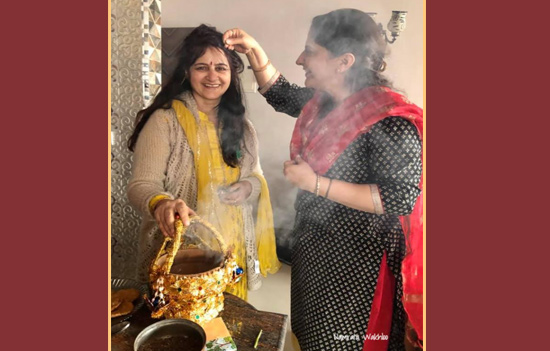 Isband
ritual.
Isband
ritual.
The Poff prepares a savoury rice porridge
called Vaer which is shared
with all friends and family. Since, all the food during the wedding days is
home cooked, a Waaza or traditional Kashmiri cook is hired along with
his team. This is the day he usually sets up the Wur - a wood-fired multi-top clay oven - in the backyard of
the house. All the feasts thereafter are cooked on this Wur.
MAENZRATH (Mehndi Night)
The Krool Kharun ritual is
performed on this day wherein the entrance of the home is decorated with
auspicious motifs and colourful frescoes by the Poff. The whole house wears a
truly festive look.
Maenz is
Mehndi and Raath is Night - the night of mehndi, song and dance – is a couple of days before the wedding. The mother’s and father’s sisters - both are key in this ceremony. The Maas - mother’s sister washes the hands and feet of the bride/groom, after which the Poff applies henna to the hands and feet in beautiful and intricate designs. The Poff thereafter goes around the room, dropping dollops of henna in everybody else’s palms who in return offer money to her as Shogun (customary
offering). The Poff makes Vaer on this day too.
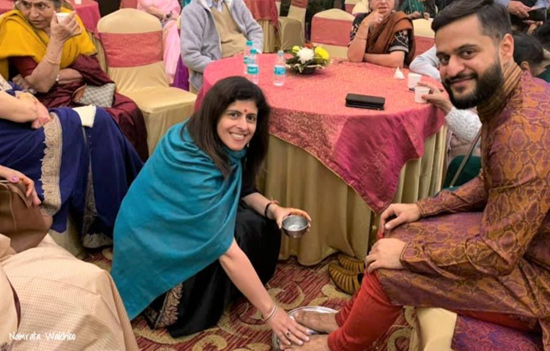 Groom’s feet being washed on Maenzrath.
Groom’s feet being washed on Maenzrath.
Family and friends apply henna designs to
their hands and feet. Steaming cups of Kehwa (green tea) are poured
from the Samavar (traditional tea-pot) through the night.
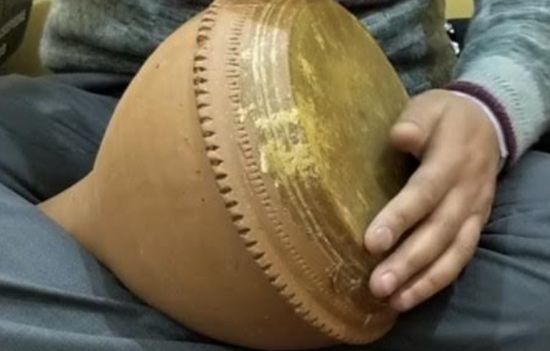 Tumbakhnaer.
Tumbakhnaer.
It’s the night for song and dance. Everyone sits down in a large group with several traditional musical instruments and sing Kashmiri songs. Tumbakhnaer is the most
auspicious of them all. A beat on this kicks-off the musical night. Tumbakhnaer
is a goblet drum made of baked clay and sheepskin. Many people, wanting a
grander ceremony, organize Bach’e Nagm’e or Gindun
Gor — a traditional Kashmiri folk singer who along with his troupe of musicians and dancers entertains everyone until the wee hours of the morning. To see Video of
Tumbakhnaer (2.30 minutes)
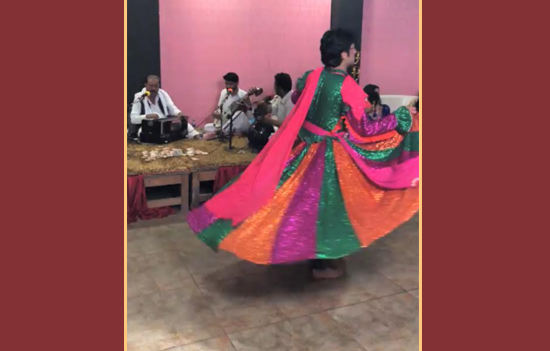 Gindun Gor - traditional Kashmiri folk songs.
Gindun Gor - traditional Kashmiri folk songs.
DIVGONE
This ritual is usually held a day before the wedding day. It marks the bride and groom’s transition from Brahmacharya to Grahasthya Ashram.
The bride and the groom, at their
respective places, are given Kanyi
Shraan - a bathing ritual. The Maamanye (maternal aunt) cleans the Vuz (main lobby of the house) and the bride/groom is made to sit at the centre. Water mixed with milk is poured over her/him through a muslin cloth which is held by four small girls (Kanya), one at each end. Following the bath, all old clothes or accessories on the bride/groom are given away and they change into new clothes which are gifted by the mother’s side of the family.
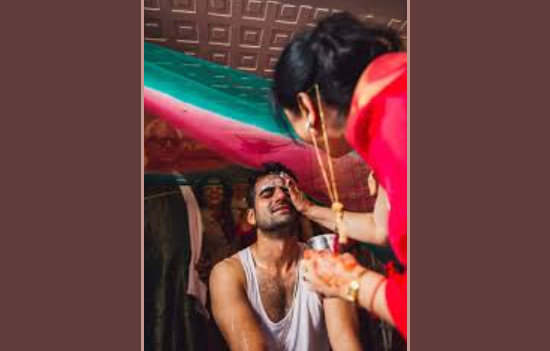 Kanye Shraan. Credits Nikhil Kapoor.
Kanye Shraan. Credits Nikhil Kapoor.
The Poff makes the hair of the bride, by
parting it right in the centre with a Daatun twig and loosely
ties it with red Narivan thread into two separate parts.
Thereafter, the bride/groom sit at
the Havan and prayers are offered to Parvati and Shiva as per Vedic rituals performed by the priest. The bride and the groom observe a fast before the puja. The bride’s gold ornaments and utensils given to her by her family are placed in front of the yagna and are sanctified during the ceremony.
It’s important to mention the Atth and Dejhoor here. You would have seen Kashmiri Pandit women wearing a gold chain with an attached pendulum in both the ears. In fact, that’s one way of identifying them as married Kashmiri Pandits. This ornament has a deep spiritual connotation. Made up of gold, Dejhoor is a shatkon or hexagon-shaped pendulum and Atth is the gold chain that holds the Dejhoor. It’s worn in both ears. The shatkon shape represents the union of Shiva &
Shakti.
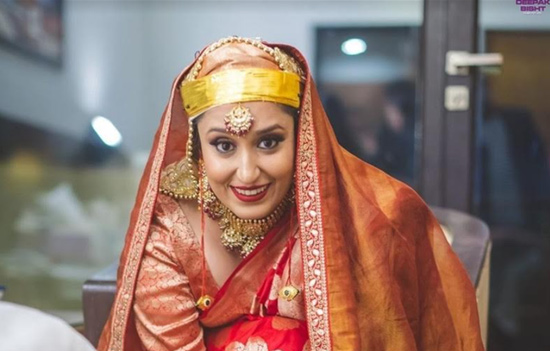 Dejhoor. Please advice credits.
Dejhoor. Please advice credits.
During the Divgone, the parents of the bride give her the Dejhoor that is worn in the ears using the red Narivan. Later, on the wedding day, after the bride goes to her in-laws’ place, they replace the red thread of the Dejhoor with the gold Atth thus signifying the union of two individuals and the respective families.
LAEGAN — The Wedding Day
Back in Kashmir, probably due to the harsh
weather conditions and fewer means, the Laegan (the main wedding
ritual) would take place during the day, at the chosen Saath. Weddings used to
be less showy and less noisy. Now, mostly all are glitzy night-time weddings.
The groom departs from his place towards the bride’s home, accompanied by his family members and friends. Only his mother stays back home. The groom dresses up in a traditional outfit like a sherwani, or in a western suit. What is worth a mention, is his headgear - a Dastaar (turban) which is tied in a particular manner by the elderly menfolk. Usually, a beautiful silk saree is used for this, to give a rich, embellished look to the groom. A black headed needle is compulsorily used in the Dastaar to ward off the evil eye! Strings of silver coated almonds, cloves and Mahraz Posh (Globe Amaranth flowers) are used to garland the groom to complete the look.
The Kashmiri bride looks absolutely
resplendent in a red saree and a stunning headgear called Taraga, which gives her a very distinct
bridal charm.
The Taraga has several layers - first comes
the Taech - which is
a snug fitting, gold embroidered zari cap. Then comes the Zooej - a delicate netted fabric
with embroidered motifs that is draped over the Taech. Over the Zooej, a
few layers of Moharlath - starched and glazed white band of
fabric, are wrapped around. The final layer is that of Baendye -
golden Gota fabric. All this is secured with the help of several gold-headed
needles. Two black-headed needles are also used, one on either side. Finally,
the Pallav of the saree covers the head.
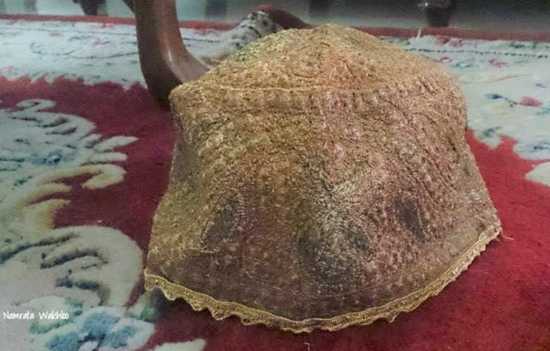 Taech or Zari Cap.
Taech or Zari Cap.
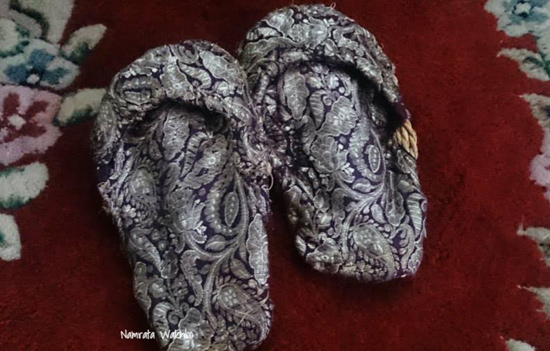 Pulhor – Straw slippers covered in brocade.
Pulhor – Straw slippers covered in brocade.
The jewellery usually worn by the bride is
all gold. The loose hair is finally tied into Khanji Lathur - two
braids with each braid split into six parts and then knotted. Each braid is covered
with golden Gota fabric and then woven into a Till’e Vaenkh (golden threaded paranda).
 The Taraga. Credits PC Soumen Nath
The Taraga. Credits PC Soumen Nath
Once the Baraat reaches the bride’s place, the women of the girl’s family welcome them with Vanvun. The groom and his family are garlanded with marigold
flowers and a conch is blown to ward off any evil. Unlike other Indian
weddings, Pandit weddings are without the customary music band and dance.
As the groom steps into the courtyard of
the house, both he and the bride are made to stand on the Vyoog - a rangoli. The eldest lady of the bride’s family does a traditional welcome of Aalath (like an Aarti) and feeds them Nabad sugar crystals. This is followed by Dwar Poozah at the main entrance of the house, a small puja performed by the priest. The bride wears a Pulhor (straw slippers) for this ceremony.
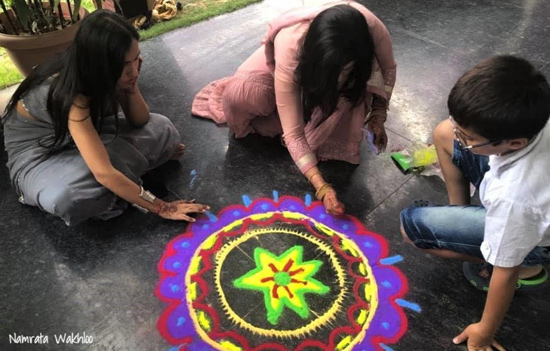 Vyoog – rangoli being made.
Vyoog – rangoli being made.
The bride, groom and their parents fast
until the Laegan is over.
The nuptial knot is tied through a long
puja as per the Vedic rituals at the Mandap where the yagna is
lit. The puja rituals are very elaborate and extend over several
hours. The father or uncle of the bride does the Kanyadaan - giving away the hand of the bride into the groom’s hands. It’s only during the puja that the couple see each other for the first time (I can see you rolling your eyes!) in the reflection of a mirror shown to them by the priest.
Through the ceremony, the groom and bride
hold hands covered with a special cloth. This is called Athwas. A
golden thread with embellishments - Mananmal - is tied to
their foreheads. The bride and the groom take seven rounds or Pheras around
the sacred fire, holding hands. The priest places walnuts in the hands of the
bride which she hands over to her father-in-law symbolizing the continuity of
progeny.
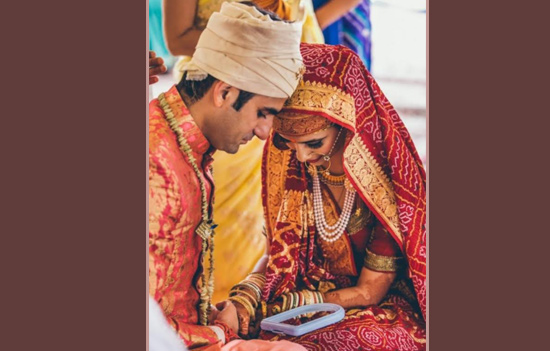 Athwas.
Please advise credits.
Athwas.
Please advise credits.
POSH’E POOZAH
This is my most favourite part of the entire wedding. The Laegan culminates with a very significant and beautiful custom. The bride and the groom, representing Shiva and Parvati sit side-by-side and a red dupatta or saree is placed over their heads. Friends and family gather around the couple and shower Posh or flowers on them while mantras are chanted by the priest. This is a flower worship of Shiv-Parvati, as one entity, hence the name Posh’e Poozah or worshipping with flowers.
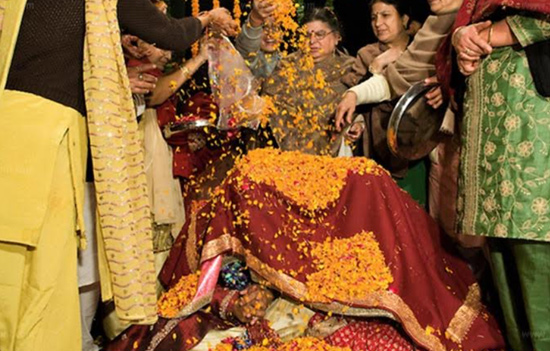 Posh’e Poozah or worshipping of flowers. Please advise credits.
Posh’e Poozah or worshipping of flowers. Please advise credits.
After this, the bride and the groom break the fast and feed each other from the same thali. When it’s time for the Baraat to return, the Maam (maternal uncle) of the bride carries her out from the window as after the kanyadaan she must leave from there. Once again, the Mahraz (groom) and Mahrin (bride), the newlyweds, stand on the Vyoog and are offered Nabad and kissed on the forehead by the eldest lady of the home. Wanvun is on.
SATRAATH
After reaching her new home, the bride is welcomed by friends and family of her husband. The Targa is undone and she is helped into a new saree by her mother-in-law. The bride at that time offers a gift to her month-in-law. She also carries gifts, like sarees, for all the women in the family. Later, that evening, the bride and groom pay a visit to the bride’s family for dinner. The bride changes into yet another saree gifted by her mother this time, and returns to her home with gifts and blessings.
PHIRLATH
This is the second time in the next few days after the wedding, when the couple visits the bride’s parents, where they join a feast and are given gifts to mark the occasion.
ROTH KHABAR
On a suitable Tuesday or Saturday, the
parents of the bride send a traditional sweet bread known as Roth to their daughter’s home. That day, the bride goes to her parents’ place for a few days with the same person who had come with the Roth.
GARR’E ATCZUN
It is a special lunch hosted at home by the bride’s and the groom’s family separately for very close family members of the other side. The meal is an elaborate fare of multiple courses.
And they lived happily ever after……
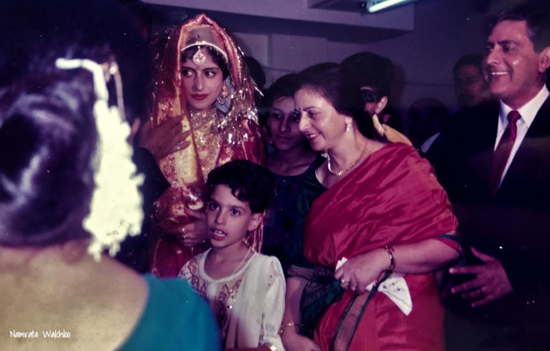 Author
as a bride.
Author
as a bride.
While some aspects of the wedding have
changed over time and with circumstances, most of the rituals have still been
retained. Dilution over time is inevitable, especially because Kashmiri Pandits
no longer live in Kashmir. I thought of scribbling down my memories, hence this
note. Most of the inputs have come from my own experience and much more from my
mother. I would be happy to add anything important that I might have missed,
please mail me at namrata.wakhloo@gmail.com
To read all
articles by author
To see Video of Kashmiri
Wedding (1 hour)
To read articles on
Wedding Ceremonies of communities across India